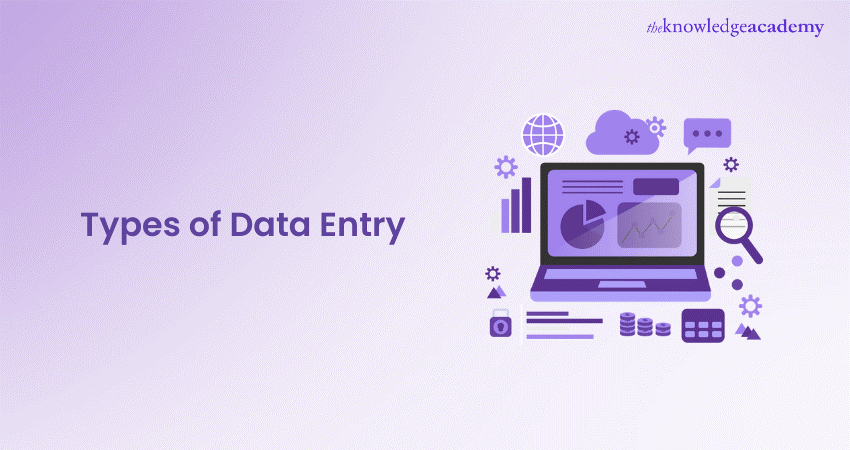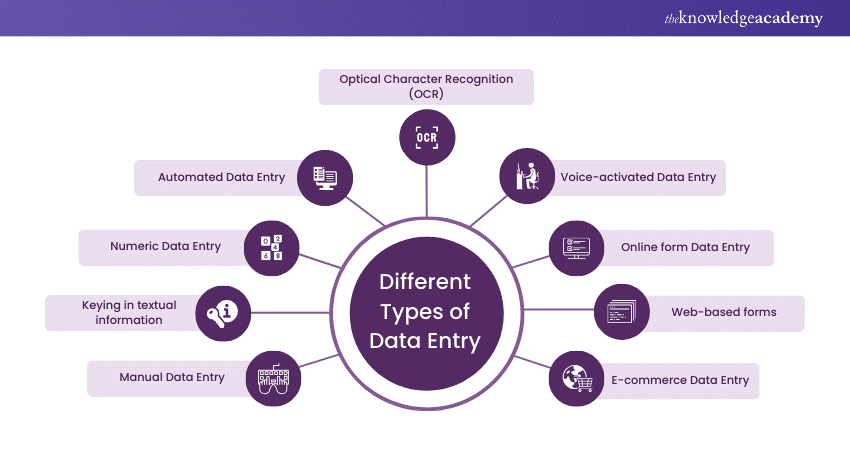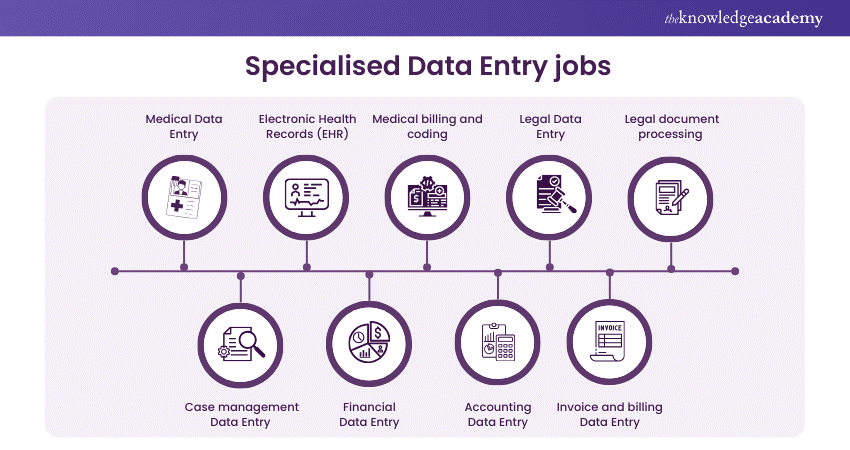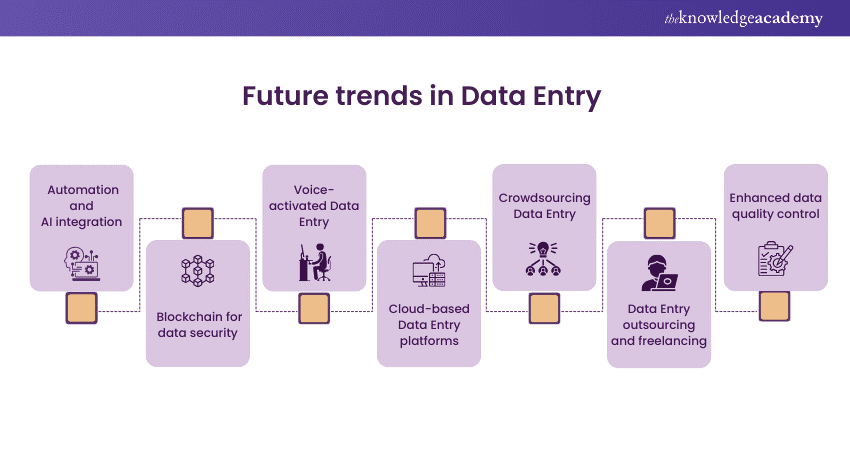We may not have the course you’re looking for. If you enquire or give us a call on +31 208081674 and speak to our training experts, we may still be able to help with your training requirements.
Training Outcomes Within Your Budget!
We ensure quality, budget-alignment, and timely delivery by our expert instructors.

Data Entry is the process of entering, updating, or verifying data from various sources into a digital format and is essential for many industries and businesses. The Data Entry professionals help organisations store, organise, and analyse information. However, not all data entry jobs are the same. There are different Types of Data Entry that require different skills, tools, and methods.
If you are a beginner in the Data Entry domain and want to know more about the Types of Data Entry, this blog is for you. In this blog, we will explore the Types of Data Entry, their features and nuances, and their opportunities in the market.
Table of Contents
1) What is Data Entry?
2) Different Types of Data Entry
3) Specialised Data Entry jobs
4) Future trends in Data Entry
5) Conclusion
What is Data Entry?
Data Entry is a fundamental process that involves feeding, organising, and managing data into computer systems or databases. This essential task plays a pivotal role in ensuring the accuracy and accessibility of information within an organisation. It comprises various activities, from manually entering data into spreadsheets to utilising advanced technologies for automated data extraction.
In its most basic form, manual Data Entry involves individuals keying in textual or numeric information. This method has been a longstanding practice, particularly in administrative tasks. With technological advancements, automated Data Entry has gained prominence, employing tools such as Optical Character Recognition (OCR) and voice-activated systems to streamline the input process.
Data Entry extends beyond mere keystrokes; it includes meticulous information handling in various industries. Different sectors rely on specific Data Entry practices tailored to their needs, from medical records and legal documents to financial transactions and e-commerce entries. As businesses increasingly leverage data for decision-making, the accuracy and efficiency of Data Entry becomes paramount.
Different Types of Data Entry
Here is a list of the common Types of Data Entry used in the industry:

1) Manual Data Entry
Manual Data Entry, the traditional method of inputting information into computer systems or databases, remains a fundamental approach in various industries. This process involves human operators entering data using keyboards or other input devices, ensuring the accurate transfer of information from physical documents to digital formats. Despite technological advancements, manual Data Entry is still crucial for tasks that demand precision and attention to detail.
Manual Data Entry is essential in maintaining accurate records in administration, finance, and healthcare. This method allows professionals to meticulously input textual or numerical data, contributing to the reliability of databases and ensuring the integrity of information. While automation technologies continue to evolve, the foundational role of manual Data Entry persists in scenarios where human expertise is essential for quality control and accuracy.
2) Keying in textual information
Keying in textual information is a fundamental Data Entry process focused on transforming written or printed text into digital formats. Operators manually input text into computer systems using keyboards or other input devices in this method. It is crucial to convert physical documents, forms, or text-based content into a digital form for efficient storage, retrieval, and analysis.
This type of Data Entry is prevalent in various industries, including administrative, legal, and academic sectors, where documents must be digitised for ease of handling and processing. Accuracy in keying in textual information is paramount to ensure the faithful representation of the original text, making it a foundational aspect of Data Entry processes.
3) Numeric Data Entry
Numeric Data Entry is a specialised form of data input primarily dealing with numerical values. In various industries, especially finance and accounting, accurate representation of numerical information is crucial for decision-making and analysis. Numeric Data Entry involves entering figures, statistics, or any data in numerical format into databases, spreadsheets, or other digital systems. This process demands precision to ensure error-free records, mainly when dealing with financial transactions, budgeting, or statistical analysis.
The emphasis on numerical accuracy makes this type of Data Entry essential for maintaining the integrity of financial records and conducting meaningful data-driven analyses. Whether handling invoices, budget sheets, or any numeric dataset, the meticulous nature of numeric Data Entry ensures that organisations can rely on accurate numerical information for their operational and strategic needs.
Keen on cracking the interview for a data entry role, refer to our blog on "Data Entry Interview Questions"
4) Automated Data Entry
Automated Data Entry is a transformative approach that harnesses technology to streamline and expedite the input of information into digital systems. Employing software or scripts, this method reduces reliance on manual Data Entry, minimising errors and enhancing efficiency. It is particularly advantageous for tasks involving large datasets or repetitive data input, where the risk of human error is high.
Automated Data Entry systems can extract, process, and input information swiftly, allowing businesses to manage vast amounts of data precisely. From financial transactions to inventory management, automation is crucial in various industries, enabling organisations to focus on more complex tasks while ensuring data accuracy and consistency.
Discover your path to excellence with our PA and Secretarial Courses – Sign up now!
5) Optical Character Recognition (OCR)
Optical Character Recognition (OCR) is a transformative technology designed to bridge the gap between printed or handwritten text and digital data. This innovative system converts text from physical documents, images, or scanned pages into machine-encoded characters that computers can understand. OCR software analyses characters' patterns, shapes, and arrangements, enabling accurate textual information extraction without manual Data Entry.
Widely used in various industries, OCR enhances efficiency by automating tasks such as document digitisation, data extraction, and text recognition. Its applications range from digitising historical documents and automating Data Entry processes to facilitating text-to-speech functionalities. OCR is pivotal in streamlining workflows, reducing manual effort, and unlocking the potential for advanced data analytics and information management in the digital age.
6) Voice-activated Data Entry
Voice-activated Data Entry represents a cutting-edge approach to information input, relying on speech recognition technology. Users can articulate commands or provide information verbally, and the system transcribes and inputs the spoken words into digital form. This method is particularly advantageous when manual input, such as hands-free environments or situations requiring quick data capture, is impractical.
This technology enhances efficiency and contributes to accessibility by enabling users with mobility challenges to interact with digital systems seamlessly. Voice-activated Data Entry finds applications in various domains, from virtual assistants on personal devices to industrial settings where workers must record information while keeping their hands free for other tasks. As technology advances, voice-activated Data Entry is pivotal in shaping more intuitive and accessible human-computer interactions.
7) Online form Data Entry
Online form Data Entry is a crucial aspect of the digital era, revolutionising how information is collected and processed. Organisations leverage online forms, such as customer feedback, surveys, and registrations. Users fill out digital forms on websites, providing electronically captured and stored information.
This method offers numerous advantages, including time efficiency, reduced paperwork, and seamless data accuracy. Online form Data Entry eliminates the need for physical forms and manual transcription, streamlining the entire information-gathering process. Additionally, it enables real-time data validation in excel, ensuring that entered information meets predefined criteria. As technology advances, online form Data Entry remains a versatile and user-friendly solution for entities across diverse sectors, facilitating effective data collection and management.
8) Web-based forms
Web-based forms have revolutionised how users interact with online platforms, enabling seamless data collection and processing. These digital forms, embedded in websites or applications, facilitate a user-friendly means of gathering information. From user registrations and feedback surveys to online purchases, web-based forms cater to diverse needs.
This Data Entry method enhances user experience and streamlines administrative processes for businesses. Users can conveniently input information, and the collected data is instantly transmitted for electronic processing. With responsive design and intuitive interfaces, web-based forms ensure accessibility across various devices, making them essential in the modern digital landscape. Whether capturing customer details, conducting surveys, or facilitating online transactions, web-based forms are pivotal in shaping efficient and interactive online experiences.
9) E-commerce Data Entry
E-commerce Data Entry is crucial to managing online stores and ensuring accurate and up-to-date product information. This process involves entering, updating, and organising product details such as titles, descriptions, prices, and inventory levels. Data Entry professionals play a vital role in maintaining the integrity of e-commerce platforms, enabling seamless transactions and enhancing the customer experience.
In e-commerce, efficient Data Entry contributes to effective catalogue management, optimising search functionality, and improving website navigation. Timely updates on product availability, pricing, and specifications are essential for attracting and retaining customers. E-commerce Data Entry professionals leverage specialised tools and platforms to handle large volumes of information, ensuring that online stores reflect the latest and most accurate details for a competitive edge in the digital marketplace.
Transform your office expertise into a competitive advantage with our Office Skills Masterclass – Sign up now!
Specialised Data Entry jobs

Data Entry is omnipresent across industries and is crucial in maintaining accurate and organised records. Each data entry job description will pertain to a certain sector and the candidates should have a clear understanding while proceeing with the job applications. However, various specialised jobs cater to specific sectors' unique needs within Data Entry. Here are some of these specialised Data Entry roles, their intricacies and their importance in diverse professional domains:
a) Medical Data Entry: Accuracy and precision are paramount in the healthcare sector. Medical Data Entry involves transcribing patient information, diagnoses, and treatment details into electronic systems. This meticulous process ensures that healthcare providers have access to up-to-date patient records, facilitating efficient and informed decision-making.
b) Electronic Health Records (EHR): EHR Data Entry focuses on creating and updating digital records of patients' health information. This includes medical history, medications, test results, and treatment plans. Efficient EHR Data Entry enhances patient care by providing a comprehensive overview for healthcare professionals, fostering better collaboration among medical teams.
c) Medical billing and coding: Ensuring the financial aspects of healthcare run smoothly; medical billing and coding. Data Entry involves translating medical procedures and diagnoses into standardised codes for billing purposes. Accurate coding is essential for healthcare facilities to receive proper reimbursement, highlighting the financial intricacies within the healthcare system.
d) Legal Data Entry: Legal professionals deal with vast amounts of information; precise Data Entry is critical for maintaining legal records. This includes entering case details, court proceedings, and client information accurately. Legal Data Entry ensures that law firms can access crucial information promptly, supporting legal proceedings and decision-making.
e) Legal document processing: Legal document processing involves organising, cataloguing, and entering information from legal documents into digital systems. This includes contracts, agreements, court orders, and other legal paperwork. The accuracy of this Data Entry is pivotal for legal research, case preparation, and maintaining compliance.
f) Case management Data Entry: In legal and social work settings, case management Data Entry involves recording and updating details related to client interactions, case progress, and interventions. This helps professionals monitor and evaluate the effectiveness of their services, contributing to improved client outcomes.
g) Financial Data Entry: Data Entry is integral to managing vast amounts of financial information in the financial sector. This includes entering transactions, updating ledgers, and maintaining financial records. Accurate financial Data Entry is crucial for financial analysis, budgeting, and regulatory compliance.
h) Accounting Data Entry: Accounting Data Entry involves recording financial transactions, including invoices, receipts, and expenditures. This meticulous task ensures businesses maintain accurate financial records, supporting financial reporting, audits, and strategic decision-making.
i) Invoice and billing Data Entry: Efficient invoice and billing Data Entry is essential for businesses to manage revenue streams. This involves entering details from invoices, purchase orders, and receipts accurately. Timely and precise billing Data Entry contributes to effective financial management and client relations.
Take the first step towards career excellence with our Data Entry Masterclass – Sign up today!
Future trends in Data Entry
Several future trends are poised to shape how Data Entry is approached, enhancing efficiency and accuracy in information management.

a) Automation and AI integration: Automation and artificial intelligence (AI) are revolutionising Data Entry. Robotic Process Automation (RPA) streamlines repetitive tasks, reducing manual efforts. AI-powered systems can intelligently extract, validate, and categorise data, minimising errors and improving processing speed.
b) Blockchain for data security: As data security becomes paramount, blockchain technology is gaining prominence in Data Entry. Blockchain ensures secure, transparent, and tamper-proof data transactions. This is particularly valuable in industries where data integrity and trust are critical, such as finance, healthcare, and legal sectors.
c) Voice-activated Data Entry: Voice recognition technology is making waves in Data Entry. Voice-activated Data Entry tools enable hands-free input, enhancing efficiency and allowing users to dictate information directly into systems. This trend is particularly beneficial when manual typing is challenging or impractical.
d) Cloud-based Data Entry platforms: Cloud-based solutions are transforming Data Entry processes. These platforms offer real-time collaboration, accessibility from anywhere, and seamless integration with other business applications. Cloud-based Data Entry enhances flexibility and scalability, accommodating the dynamic needs of modern businesses.
e) Crowdsourcing Data Entry: Crowdsourcing is emerging as a viable solution for large-scale Data Entry projects. Organisations can efficiently handle massive datasets by harnessing the collective efforts of a distributed workforce. This approach enables scalability and cost-effectiveness, especially for tasks requiring diverse skills.
f) Data Entry outsourcing and freelancing: Outsourcing Data Entry tasks to specialised agencies or freelancers is a growing trend. Businesses can leverage external expertise for specific projects, allowing in-house teams to focus on core competencies. Freelancing platforms provide a global pool of skilled Data Entry professionals for on-demand tasks.
g) Enhanced data quality control: Quality control mechanisms are becoming more sophisticated. AI-driven algorithms can analyse patterns and anomalies, ensuring data accuracy. These systems can detect errors, inconsistencies, or outliers in real-time, preventing inaccuracies from proliferating through datasets.
Conclusion
In conclusion, understanding the diverse landscape of Types of Data Entry is crucial for businesses navigating the digital age. Each type of Data entry jobs require a specific data entry skills to excel. From traditional manual entry to cutting-edge AI-driven processes, each type plays a vital role. Tailoring Data Entry strategies to specific needs ensures efficient, accurate, and future-ready information management in the ever-evolving business landscape.
Refine your office management prowess with our comprehensive Office Manager Masterclass today!
Frequently Asked Questions

Specialised data entry roles demand specific skills. In medical data entry, attention to detail, knowledge of medical terminology, and proficiency in Electronic Health Records (EHR) systems are crucial. Legal data entry requires precision in handling legal documents, understanding legal terminology, and familiarity with case management systems. Both roles necessitate accuracy, confidentiality, and adaptability to industry-specific software, ensuring data integrity in these critical domains.

Specialised data entry, such as medical or legal, requires industry-specific knowledge and attention to detail. Accuracy is crucial for patient safety in medical data entry, involving tasks like managing Electronic Health Records (EHR) and medical billing. Legal data entry involves the precise processing of intricate legal documents, ensuring compliance with legal standards. These specialised fields demand expertise beyond general data entry, emphasising the importance of domain-specific skills.

The future of data entry is significantly impacted by emerging technologies such as Artificial Intelligence (AI), Robotic Process Automation (RPA), and Optical Character Recognition (OCR). These advancements streamline data processing, reduce errors, and enhance efficiency across diverse industries, ensuring a more automated and intelligent approach to data entry tasks.

The Knowledge Academy takes global learning to new heights, offering over 30,000 online courses across 490+ locations in 220 countries. This expansive reach ensures accessibility and convenience for learners worldwide.
Alongside our diverse Online Course Catalogue, encompassing 17 major categories, we go the extra mile by providing a plethora of free educational Online Resources like News updates, Blogs, videos, webinars, and interview questions. Tailoring learning experiences further, professionals can maximise value with customisable Course Bundles of TKA.

The Knowledge Academy’s Knowledge Pass, a prepaid voucher, adds another layer of flexibility, allowing course bookings over a 12-month period. Join us on a journey where education knows no bounds.

The Knowledge Academy offers various PA and Secretarial Courses, including Data Entry Masterclass, Administrative Assistant, Secretarial Masterclass, and many more. These courses cater to different skill levels, providing comprehensive insights into Business Skills methodologies.
Our Business Skills blogs cover a range of topics related to Data Entry, offering valuable resources, best practices, and industry insights. Whether you are a beginner or looking to advance your Business Skills, The Knowledge Academy's diverse courses and informative blogs have you covered.
Upcoming Business Skills Resources Batches & Dates
Date
 Company Secretary Training Course
Company Secretary Training Course
Fri 14th Feb 2025
Fri 11th Apr 2025
Fri 13th Jun 2025
Fri 15th Aug 2025
Fri 10th Oct 2025
Fri 12th Dec 2025







 Top Rated Course
Top Rated Course



 If you wish to make any changes to your course, please
If you wish to make any changes to your course, please


